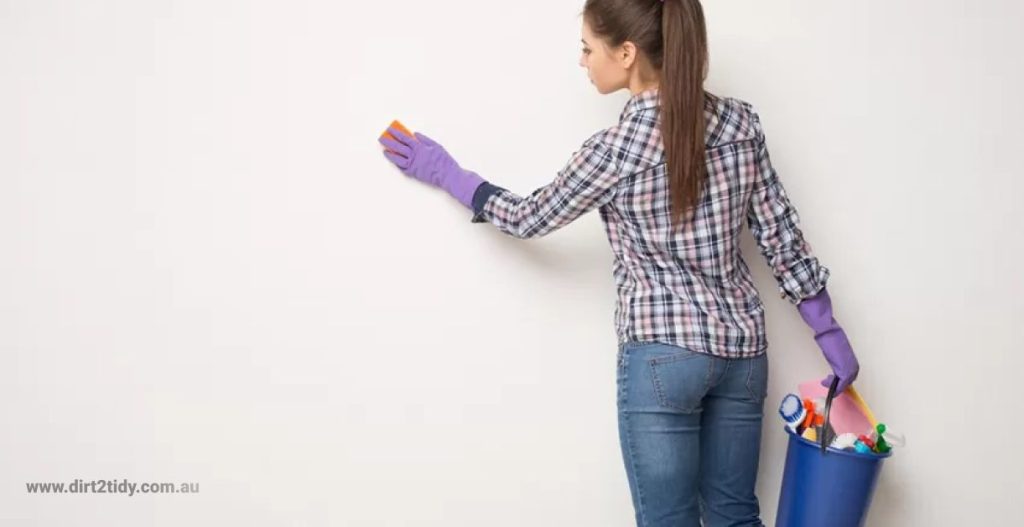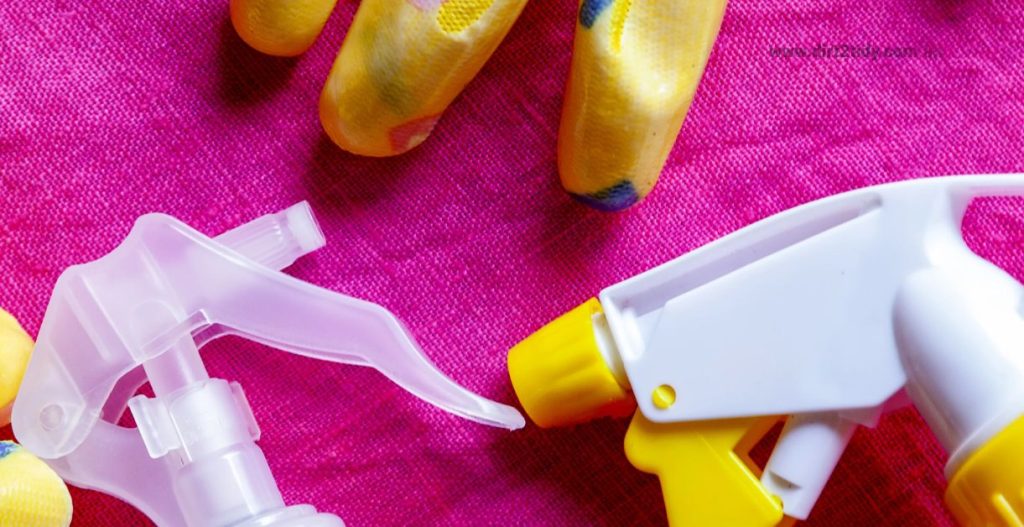Table of Contents
We’re talking about your inside walls, of course, which are one of the most important components of a home’s construction yet are nearly never cleaned and considered an inconspicuous area.
The outside of a home’s walls is just as significant as its general condition. In fact, the features of these two elements taken together have a significant influence on your home’s overall look and require regular cleaning to remove those stubborn stains.
So, when was the last time you really considered cleaning your walls, much alone actually did it? There’s a strong probability that your once-immaculate walls have fallen victim to drabness and haphazard stains over the years if it’s been long enough (or never).
Fortunately, with a safe and thorough cleaning procedure, your interior walls will appear as good as new! Dust, filth, and even black mould may make well-maintained walls seem pretty dreary.
Here is a straightforward, step-by-step approach starting at the top of cleaning your walls in the cleanest and safest manner possible.
Get Ready for The Cleanup
You will need complete access to your internal walls in order to clean them from top to bottom thoroughly. This implies that the surface shouldn’t be blocked by furniture or wall decorations.
Therefore, in order to clean more effectively, you should remove picture frames and other wall decor first. Then, move furniture away from the walls.

It’s Time to Collect the Materials You’ll Need to Finish Our Wall Cleaning Technique:
Gather Your Cleaning Toolkit
For a successful wall cleaning session, both general and specific tools are essential. Here’s what you’ll need:
- Magic Eraser – Ideal for tackling stubborn stains on white walls.
- Ladder – To reach those high spots.
- Vacuum Cleaner and Broom – Essential for removing dust before washing.
- Cleanup Cloths and Soft Sponges – For general cleaning and spot treatments.
- Absorbent Towels – Useful for drying and blotting moisture.
- Liquid Dish Soap or White Vinegar – These are versatile for creating effective cleaning solutions.
- Bucket with Warm Water – For mixing your cleaning agents.
Clean the Surface of Dust and Dirt
Before washing, it’s crucial to remove all dust and debris to prevent transferring grime during the cleaning process.
- Start from the Top – Use a brush or vacuum to clean from the top of the wall down, ensuring you have the right attachment to avoid paint damage.
- Mind the Corners – Pay attention to corners, often dust traps, by using a dust cloth after vacuuming to ensure a clean surface.
Prepare the cleaning agent
Painted walls, especially white ones, can be brightened with a simple homemade solution.
- Vinegar Solution: Mix 1 gallon of water with 4–5 teaspoons of white distilled vinegar.
- Dish Soap Solution: Add 4-5 drops of liquid dish soap to a bucket of water.
Before applying, always do a “spot test” on a hidden area to ensure there’s no damage or discoloration.
Here’s how to prepare both:
Vinegar: Add 1 gallon of water to 4–5 teaspoons of white distilled vinegar.
Pour 4-5 drops of liquid dish soap into a bucket’s worth of water to use as dish soap.
No matter the cleaning agent in issue, it is wise to do a “spot test” by applying the cleaner to a discrete area of the wall to be sure it won’t harm or discolour it.
To do this, gently clean the wall with a sponge dipped in the solution and let it dry fully before inspecting for damage. Before beginning the wall cleaning procedure, if necessary, try a different cleaning solution.
Clean Spot Stains
When we say wash, we just mean wiping the wall with a moist sponge, not spraying water on it. Before you start, lay out some drop cloths to catch any drips that may occur while you do this task.
- Dampen and Wipe: Ensure your sponge is not dripping wet. Wipe from top to bottom in sections, rinsing the sponge regularly to avoid re-contaminating the surface.
- Blot Excess Water: Immediately blot any drips to prevent streaks.
How to Effectively Clean Grease Stains from Walls
Cleaning grease stains from walls can be a daunting task, but with the right approach, it becomes simple and effective. Here’s how you can tackle those stubborn stains without breaking a sweat.
DIY Natural Cleaner
- Mix a Solution: Combine equal parts of lemon juice or white vinegar with water. Both lemon juice and vinegar are natural acids, which makes them superb for breaking down tough grease and grime.
- Spray and Wipe: Apply the solution to the stained areas using a spray bottle for even coverage. Allow it to sit for a minute, then gently scrub with a soft sponge.
Commercial Cleaner Option
If you’re looking for a commercial solution, sugar soap is renowned for its effectiveness. Dilute the sugar soap as instructed on its packaging and use it to clean the grease from your walls. It’s designed to tackle tough stains and can be a great option if natural methods need a boost.
Both these methods are effective for removing grease without damaging the paint or tile surfaces, leaving your walls looking fresh and clean.

Cleanse the Wall
When we say wash, we just mean wiping the wall with a moist sponge, not spraying water on it. Before you start, lay out some drop cloths to catch any drips that may occur while you do this task.
To prevent soaking the wall, begin by dipping the sponge into the bucket and squeezing out all the extra water. Make sure the sponge is not dripping wet. One part at a time, gently wipe the wall from top to bottom. To prevent re-contaminating the surface, periodically rinse the sponge.
To avoid stains, instantly blot any water that drips down the wall with a towel or piece of fabric (caused by dirt on the surface.
How to Clean Flat-Painted Walls
When tackling the cleaning of flat-painted walls, it’s crucial to adopt a gentle approach. Unlike gloss paints, flat and satin finishes are more delicate and can easily show wear if not treated with care. Here’s a step-by-step guide to keeping your flat-painted walls in top condition:
- Gather Your Tools:
- Warm Water: Opt for warm, not hot, to avoid damaging the paint.
- Sponge: A soft sponge will help you clean without scratching.
- Microfiber Cloth: Essential for drying and buffing walls to prevent streaks.
- Preparation:
- Wet the sponge in warm water and squeeze it until it’s nearly dry. This ensures you’re using just enough moisture to clean without soaking the wall.
- Cleaning Process:
- Gently wipe the walls with the damp sponge, focusing on one small section at a time. Rinse the sponge regularly to avoid spreading dirt around. Always wring it out thoroughly after rinsing to maintain the right dampness.
- Drying:
- Once cleaned, immediately dry the area with a microfiber cloth to prevent water spots and streaks.
Tips and Tricks
- Avoid using harsh chemicals or degreasers, as these can fade or damage the paint.
- For stubborn spots, a mixture of water and mild dish soap might help, but test it in an inconspicuous area first.
- Regular maintenance is key; dusting walls with a dry microfiber cloth periodically can minimize the need for intense cleaning.
By following these steps, you can keep your walls looking fresh and maintain their original beauty over time.
Embrace moisture
It’s recommended to avoid leaving too much moisture on your walls since doing so will cause them to take longer to dry and expose paint finishes to possible harm. As a result, we suggest blotting the whole wall with a white towel or other absorbent material to absorb as much moisture as you can.
As soon as the towel or cloth gets moist, be sure you swap it out for a dry one. After completing this process, turn on the room’s ceiling fans and open the windows to promote ventilation, which will hasten the drying of the walls. To guarantee that the whole wall dries up as rapidly as possible, keep the fans running all night.
Maintaining Your Walls
Nothing, not even routine upkeep and cleaning, can keep your walls clean. Focus on high contact areas like light switches, door frames, and doorknobs to preserve the cleanliness and attractiveness of your interior walls.
Keep in mind that the more often you clean your interior walls, the less probable it is that they will develop dullness and persistent stains.
. To maintain pristine walls, consider the following cleaning schedule:
- Immediate Action: Tackle stains and splatters as soon as they occur to prevent them from setting in and becoming more difficult to remove.
- Weekly Routine: Focus on cleaning the walls in high-traffic areas, such as those around your shower, door handles, and light switches. These spots tend to accumulate grime more quickly.
- Monthly Deep Clean: Dedicate time each month for a thorough cleaning of your walls and skirting boards. Begin by dusting the surfaces to avoid spreading dirt while cleaning.
The wall cleaning instructions above are ideal for making the inside walls of your house seem brand-new, and if followed every few months, will keep them looking fantastic for years to come. By adhering to this routine, your walls will retain their fresh appearance, enhancing the beauty and cleanliness of your home.
How to Properly Clean Wallpapered Walls
Cleaning wallpapered walls requires a gentle approach to preserve their appearance and prevent any damage. Here’s a simple guide to help you maintain your wallpaper:
- Dust Regularly: Routine dusting is usually sufficient. Use a soft, microfiber cloth or a feather duster to remove surface dust without scratching or damaging the wallpaper.
- Handle Spots with Care: For small smudges or marks, employ a dry cleaning sponge or gum eraser. These tools are effective yet gentler on the wallpaper. Remember to apply only gentle pressure to avoid tearing or discoloration.
- Avoid Abrasive Materials: Stay clear of coarse cloths, scrubbing pads, and abrasive cleaners. These materials can scratch the surface or strip the wallpaper of its finish.
Remember, the key is to be gentle and cautious. Regular dusting and careful spot cleaning will keep your wallpaper looking fresh and vibrant without the need for harsh cleaning techniques.
How Can I Effectively Clean Mould From Walls?
Understanding the Risk:
Mould and mildew are not only unsightly, but they also pose serious health risks. It’s crucial to tackle these issues as soon as they appear to ensure a safe living environment.
Assessment First:
Begin by evaluating the severity of the mould problem. Check if the mould has caused structural damage to your walls. In cases of significant damage, consulting with construction professionals is advisable. They might suggest wall replacement to completely eliminate the root cause of the mould.
DIY Mould Removal:
If the walls are structurally sound, you can proceed with cleaning. Here are two methods using common household items:
- Using White Vinegar:
- Spray undiluted white vinegar directly onto the mould-affected areas.
- Allow it to sit for 30 minutes to break down the mould spores.
- Wipe the area clean with a damp cloth.
- Using Bleach:
- Mix one part bleach with three parts water.
- Apply the solution to the mould using a sponge or rag.
- Always wear protective gloves to avoid skin irritation.
Both methods are effective, but vinegar is a gentler option if you’re concerned about harsh chemicals. It’s always a good idea to ventilate the area well during and after the cleaning process.






